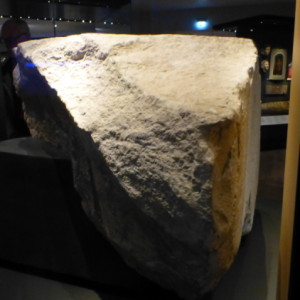Limestone casing stone from King Khufu's Pyramid.
The National Museum of Scotland has opened the final three galleries of an £80m redevelopment of the 152-year-old institution. Over the past 15 years, the Edinburgh museum has added 29 new galleries with space for 13,000 objects. The latest new galleries are devoted to Ancient Egypt, East Asia and the Art of Ceramics. On this, the first day of opening, we visited the Egyptian area; the extra is the rear view of the stone, on close examination there is evidence of fossils.
One of the few surviving casing stones from the Great Pyramid of Giza, dating to 2589-2566 BC and built for King Khufu, it was part of an outer layer of fine white limestone, polished until it shone. Each casing block was transported from quarries 15km downriver.
The stone arrived in Edinburgh in 1872, having been found in rubble among roadworks by an engineer who was working for Charles Piazzi Smyth, the Astronomer Royal of Scotland, brought to Edinburgh and displayed in his home.
Piazzi Smyth conducted the first survey of the Great Pyramids, with permission from the Viceroy of Egypt and the Egyptian Antiquaries Service.The item sparked controversy as the authorities in Egypt were keen to know how it had come to be in a Scottish museum and had never been displayed. However, when it was announced it would be put on show in the new gallery the present-day Egyptian Antiquaries Repatriation Department asked the museum for evidence of its provenance. Museum director Dr Gordon Rintoul is adamant the paperwork is in order and that the stone is the centrepiece of their new gallery. It is currently the only stone of its type on display outside Egypt.

Comments
Sign in or get an account to comment.


